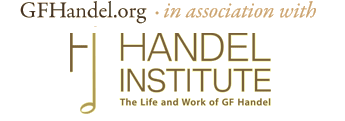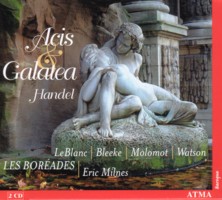Inspired from Ovid, the pastoral masque Acis and Galatea was
composed in 1718 when Handel was working for James Brydges, Earl of
Carnarvon (later the 1st Duke of Chandos). It was probably first performed
at Cannons, Brydges’ country residence near modern-day Edgware. From a
dramatic point of view, it is certainly not one of the most fascinating
works by Handel. But Handel’s intention was not to create an opera, and nor
can this masque be compared too closely with Handel’s operas, oratorios or
even some cantatas. Its structure and nature is influenced by the
circumstances of its first performance, notably by the small musical band
working for Brydges at that time. From the beginning until the chorus ‘Happy
we’ the work is mainly a charming pastorale. Then the work plunges into a
more tragic prospect with the strongly contrasting chorus ‘Wretched lovers’.
While it is unfair towards Handel if we suggest that the first part – with
its languid pastoral rejoicing – did not inspire him, the second part
relating Acis’s murder by the jealous giant Polyphemus gave him quite a few
occasions to develop ideas with his customary dramatic skill.
Suzie LeBlanc is occasionally vulnerable in her slowest sustained
passages, but she is an absolutely charming Galatea, and her relative vocal
fragility does contribute to this perfectly suitable charm. The two tenors
produce honourable performances, but are more stylistically erratic than
LeBlanc. Their singing technique is not always appropriate, particularly
concerning the highest notes, and they occasionally have difficulty staying
perfectly in tune. Nathaniel Watson’s Polyphemus calls for few criticisms,
even if maybe a darker voice might have been expected. It is worth noting
that the effect of the singing is much stronger in the choruses, though sung
by the same soloists. This soloist choir offers the most beautiful moments
of the recording. ‘Mourn, all ye muses!’ is heard here with very special
impact, and ‘Wretched lovers’ is a particularly beautiful example of both
descriptive and dramatic counterpoint. Eric Milnes’ articulated approach is
very effective here thanks to the quality of the singing, although the
impact of the orchestra is less strong as it is also less accurate.
Milnes is responsible for some common musicological inaccuracies. For
example, the third tenor is here an alto and his aria is given to Damon, and
there are also some unsanctioned additional recorders in some arias.
Therefore this is not a perfect recording, but it is a really enjoyable one
that offers some marvellous moments rarely heard even in globally better
recordings.




